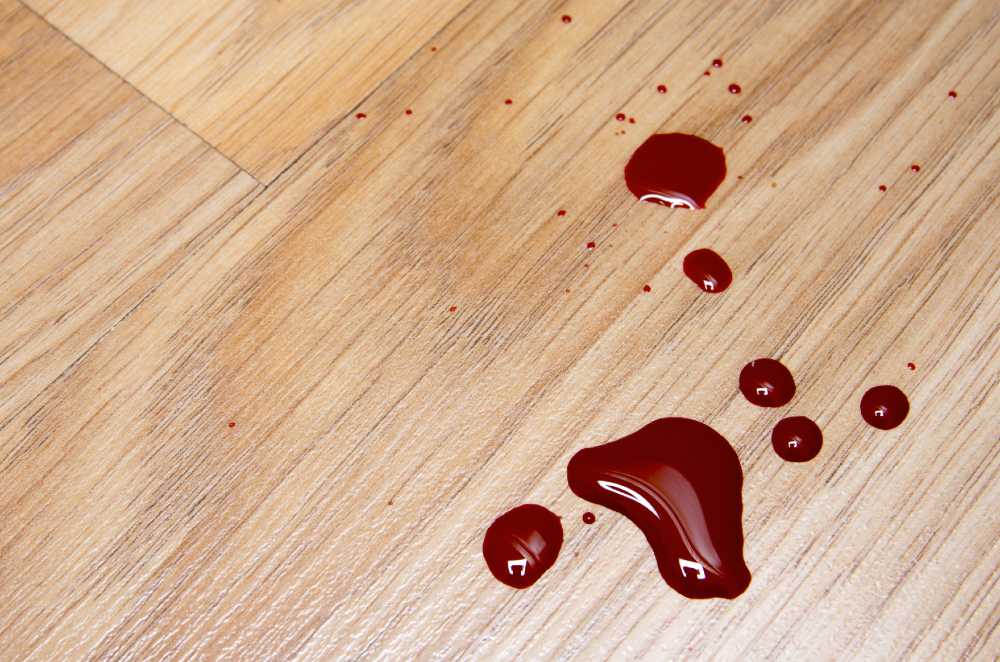You might not think twice about cleaning up blood, however, it’s more dangerous than you know. While it’s safe to remove a small amount of blood, you should never clean up a large blood spill. We look at how to clean up blood spills safely as well as cover the health risks of blood. Plus, we cover when you absolutely need to call a restoration company.
How to Clean Up Minor Blood Spills
You can safely clean up minor blood spills as long as you take the precautions first. We consider a minor blood spill anything less than six inches in diameter.
- Remove Solid Objects – First, you need to remove any solid object. You should never pick anything up with your hands, so use tongs or forceps. Remove large shards of glass, chunks of metal and other items. Then use a brush and dustpan for smaller items or tiny pieces of glass. Place everything you pick up into a sharps container.
- Soak up Blood – Use rags or towels to soak up all of the wet blood. Instead of wiping, which can smear blood, dab or blot blood to soak it up. Then place contaminated rags and towels into a clearly marked biohazard bag. Make sure you remove all of the blood before moving on, as the disinfectant will not work properly otherwise.
- Disinfect the Area – Always read and follow the directions for your disinfectant, taking special note of the contact time. After the required time has passed, scrub the stain with fresh rags or towels. You should always work from the outside to the inside of the stain for the best results. Make sure you put all used towels into the biohazard bag as well.
- Blot the Area With Disinfectant – Next, soak fresh rags in the disinfectant and press them into the stain. Let the rags soak on the stain for the required contact time. Then put these rags into the biohazard bag for disposal.
- Decontaminate Cleaning Tools – Treat the tools like the dustpan and tongs with the disinfectant. Make sure you allow them to soak for the required contact time before rinsing it off.
- Dispose of All Contaminated Items – Carefully remove your gloves and goggles and place them in the biohazard bag. Always avoid overfilling bags to prevent leaks or tears while carrying them. Never throw away biohazards with your regular garbage. Instead, contact the health department in your area for disposal instructions.
- Check for Contamination – Check the decontaminated area as well as your clothing and skin for signs of blood. While you can check the area yourself, it’s helpful if you have someone else check you for contamination.
- Wash Up – After checking for contaminations, thoroughly wash your hands, arms and any exposed skin with soap and warm water for at least thirty seconds.
- Document and Report the Accident – If the blood spill occurs in the workplace, make sure you follow your accident procedure and fill an incident if necessary.
What Do You Need To Cleanup Blood?
Before cleaning up blood, you will need the following items:
- Disposable gloves
- Goggles
- Rags or towels
- Biohazard bags
- Biohazard labels
- Leak-proof sharps containers
- Brush and dustpan
- Tongs or forceps
- Broad-spectrum disinfectant
If you do not have these items or cannot locate them within fifteen to thirty minutes of the accident, you should hire a restoration company instead.
Can I Clean up Blood With Bleach?
Although bleach is a powerful disinfectant, it won’t always kill bloodborne pathogens. For your safety, you should only use a registered disinfectant with a broad spectrum kill claim.
Why Is It Dangerous To Clean up Blood?
Since it can carry many different types of diseases, it is dangerous to clean up the blood. The most common diseases include HIV, Hepatitis B, Hepatitis C and MRSA, however, blood can spread any bloodborne pathogen.
For this reason, you should always assume blood is contaminated. Even if it’s from a friend or family member, there is always the possibility that they don’t know they are infected.
When Is It Safe To Clean up a Blood Spill on Your Own?
In some cases, it is safe to clean up a blood spill by yourself. While you still need to take precautions, it is safe to clean up a blood spill given the following conditions:
- Only when you can wear the proper safety equipment
- There is less than a six-inch area of blood
- If it’s your own blood or from an immediate family member
- If it’s on a hard surface like countertops, tile or vinyl floor, metal or glass
When Is It Not Safe To Clean up a Blood Spill by Yourself?
However, you should not clean up a blood spill on your own if even one of the following is true:
- Any time you do not have the proper safety equipment
- If there is more than a six-inch area of blood
- The blood is from anyone outside of your immediate family, especially strangers
- It’s on a porous surface like carpeting, fabric, walls, cabinets or anywhere blood can soak in
- There is more than one section of blood or it has splattered or sprayed through a room
If you cannot safely clean up blood spills, Restoration Local is here to help. Call 1-888-443-3110 now for a risk-free estimate on blood cleanup services. Our restoration specialists offer 24-hour service and 30-minute response to limit the damage and keep you safe.





